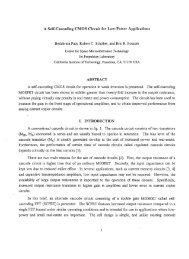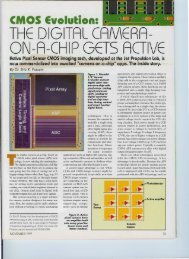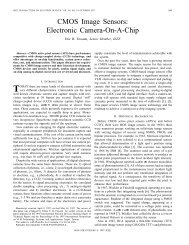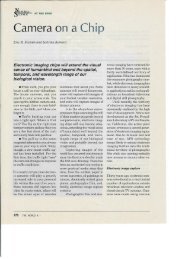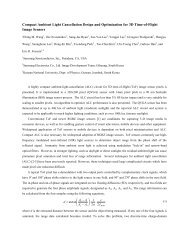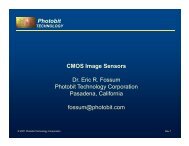Infrared readout electronics for space science sensors - Eric Fossum
Infrared readout electronics for space science sensors - Eric Fossum
Infrared readout electronics for space science sensors - Eric Fossum
Create successful ePaper yourself
Turn your PDF publications into a flip-book with our unique Google optimized e-Paper software.
times, reaching as low as 1.88 electrons <strong>for</strong> the smallest integration time of 42 tsec. SBRC LWIR low background, highspeed, high sensitivity JR FPA was built as linear array with 260 elements and 25 m pitch [3 1]. Using a 30 ifintegration capacitance, and <strong>for</strong> an integration time of 42 isec., less than 120 electrons input-referred noise was obtainedat 65K operating temperature. The per<strong>for</strong>mance characteristics of a few selected CTIA <strong>readout</strong>s are presented in table 2.4. NOISE REDUCTION STRATEGIESIn this section, we present various noise reduction schemes that are used with JR FPAs. Most of the noise reductionschemes are complicated in implementation, and are usually carried out digitally off-chip.4. 1 Correlated Double Sampling (CDS)Correlated double sampling virtually eliminates kTC reset noise by measuring the output after the reset, and the outputwith the integrated signal, and computing the difference between the two [32], as shown schematically in fig. 9a. CDScan be implemented in the unit cell as a clamp-and-sample circuit. A clamp-and-sample circuit uses an a.c. coupledcapacitor in the unit cell to remove the amplifier offset (including reset noise) level. CDS is also implemented off-chip bycollecting two digital samples from the sense node, one representing the reset level and another, the level after thephotocharges have been integrated. Since the signal is generated by computing the difference of two data samples, CDScan also reduce 1/f noise and FPN, albeit at the cost of increased white noise contribution.The per<strong>for</strong>mance of the CDS circuit depends on the product of the correlation time (tc), defined as the time intervalbetween the collection of two data samples, and the output amplifier cut-offfrequency (f0) [33]. For a large tcfo, crosstalk and reset noise is reduced but the white noise and 1/f noise is increased. Since the correlation time is the same as thepixel integration time <strong>for</strong> most JR FPAs, the CDS scheme used in IR FPAs is constrained to operate with large ? values inlow background applications. There<strong>for</strong>e, the 1/f noise reduction potential of CDS in JR FPAs is somewhat limited,especially when the integration time is long, while the data rate is high.A modified CDS is often used to improve the 1/f noise reduction characteristics of a CDS circuit used in low backgroundJR FPAs. Jn the modified CDS circuit 1341, two sets of closely <strong>space</strong>d double samples are collected as shown in fig. 9b.Prior to photocurrent integration, the reset noise and the offset is measured by computing the difference between the resetlevel be<strong>for</strong>e and after the reset transistor is shut off. The signal, corrupted by the reset noise and offset, is measured at theend of the integration period by computing the difference between the data level be<strong>for</strong>e and after the unit cell is reset.Since the resultant correlation times are much smaller, superior 1/f reduction is achieved, while the white noiseapproximately doubles compared to simple integrate and read approach, and the power dissipation increases due toincreased data rate. The modified CDS has been used by Cincinnati Electronics in their 256x256 InSb JR FPA operatingbetween 4 -77 K, in order to reduce the excess noise [91.4.2 Multiple Correlated Sample Read (MCS)The analog multiplexer in the IR FPA <strong>readout</strong> can sometimes become a major contributor of noise, resulting fromspurious capacitive coupling. The multiplexer noise which is also dependent on the clocking scheme, can be as high as400 noise electrons even <strong>for</strong> a small 58x62 array [35]. For reduction of this clocking noise, multiple correlated sampling(MCS) technique has been suggested. In the MCS technique (illustrated schematically in fig. 9c), the signal is nondestructively sampled multiple times both at the beginning and at the end of the integration time. Jf a total of 2N samplesare collected, the signal to noise ratio improvement is approximately square root of N. For a 2OO sample MCS, 10electron read noise has been achieved [24]. One obvious disadvantage of this method is the vastly increased data rate,limiting its use <strong>for</strong> large <strong>for</strong>mat, high data rate JR FPAs.4.3 Non-Uni<strong>for</strong>mity Calibration (NUC)hR FPAs, like most other scientific <strong>sensors</strong>, require pixel by pixel calibration to eliminate the effects of both detector and<strong>readout</strong> <strong>electronics</strong> non-uni<strong>for</strong>mities. For example, both signal offset and gain vary from pixel to pixel. Unlike many276 / SPIE Vol. 2020 <strong>Infrared</strong> Technology XIX (1993)



